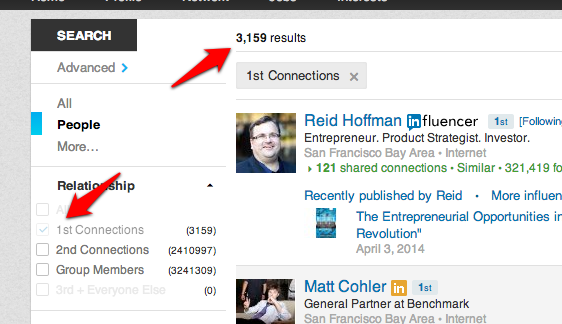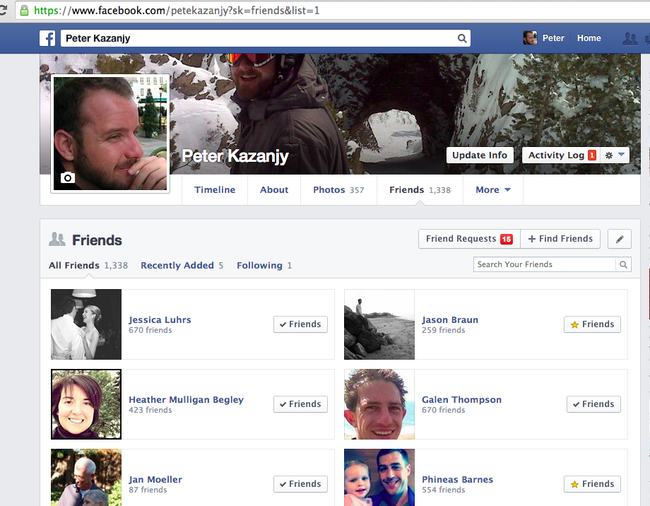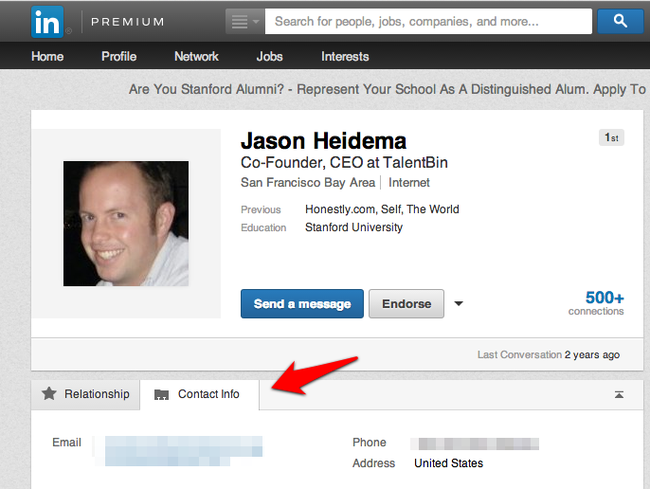Referral Recruiting Strip Mining: Methodical Network Recruiting for Early Stage Hiring Gold

This ain’t panning in a stream. We’re mechanized here, son.
This post also ran (with less profanity) in First Round Capital’s “First Round Review” [here](firstround.com/article/Mine-Your-Network-for-Early-Stage-Hiring-Gold).
Do you know where your first 10 employees are going to come from?
Your and your staff’s network. You probably already knew that.
But do you know how to go about mining that network in a proactive, intentional, methodical fashion to make the most of it?
Probably not.
This is how to proactively mine your and your staff’s networks for early stage hiring excellence. #
Many, many others have talked about the importance of the first people on your team being high quality because that’s where your next hires will come from. Birds of a feather flock together, etc. etc.
I believe this, and am going to assume for the purpose of this post that you do too.
But those same folks who espouse the importance of network hiring don’t talk about the process by which you get those hires out of your networks.
This is how to do that.
The secret is about proactive referral recruiting.
Traditional referral recruiting where your staff kinda knows what roles you have open, and kinda has an inkling of who in their network could be a good fit, and kinda thinks about this when they’re not doing their actual job is a watered down version of this, and it’s still is a great source of hire.
So imagine the results when you pour some rocket fuel on that.
The key to this is making it someone’s actual job to a. proactively mine staff networks b. extract reputation information from those staffers about their network, c. execute scaled outreach to the surfaced potential candidates.
The old saying of “if it’s everyone’s job, it’s no one’s” very much applies here. If you make it your job, it will get done. Leaving it up to non-recruiting-minded people to magically do it on their own is not a recipe for success, no matter the size of your referral recruiting bonus or how much “social referral” gimmickery you have tweeting / Facebook posting your jobs into their feeds.
Treat it like a sales campaign; you’ll get results.
(Are we seeing a theme here? Approach a problem in a rigorous, B2B sales mindset, and you get good outcomes! What works for revenue works for public relations works for recruiting! But that’s an aside.)
Tried and True Approach
Many high quality recruiting leaders implement this in their own way. Patrick Burke, now at Pebble, but previously at Apple, Square, and Houzz implements it via group referral recruiting sessions, followed up by individual debriefs. Tim Diss, formerly of Genentech and now at Facebook, does what they call “Ninja Hunting”, focused on proactive elicitation of referrals from existing staff. Tim Wenzel at Chegg used to do “recruitathons” with chocolate fountains and pizza to get folks to surface names. Theresa Singh of Causes, Asana, and Stripe is a fan of similarly-framed recruitathons in group settings – typically sharing a google spreadsheet to surface names and social hyperlinks.
This is my implementation of this approach.
It comes down to a. lead generation via network mining, b. direct recruiting outreach using social proof, c. repetition of the process.
Lead Generation: finding the candidates #
This can be done for all manner of staff, from engineering to customer success to sales. Because I have over the last year and some been focused on scaling a sales team, I’m going to use that as the example.
The first thing you need to do is a methodically mine your, and your staff’s networks, one on one, one by one.
Generally speaking, if you have your organization set up for success, your staff are going to be excited to surface their highest quality friends and colleagues as prospective hires. Even better if you offer a referral recruiting bonus. That varies, but generally speaking $1-$2k for non-engineering staff, and up from there for engineering is market rate.
So the quid pro quo here is: they surface their best contacts, and contact information for you to reach out to, and then assist in the selling process if a contact makes it down the hiring funnel. And in return, if someone gets hired, your staffer gets a referral bonus, gets to work with a high quality person, and the value of the company is accelerated through the acquisition of more high quality human capital. Oh, and someone else did all the work for them.
Sweet deal, eh?
When doing this lead gen exercise, you have to emphasize that you’re not asking them for people who are looking for work, or people who might move roles, or so on. That’s over-limiting. The single piece of data you’re trying to extract from them is “Does this person meet our hiring bar?” All other information can likely be accreted somewhere else, but this reptuation information – validated by a trusted source (the person you already hired, who ostensibly met your hiring bar, and who’s doing the referring) is not available anywhere else. That’s what we’re trying to extract here.
I like to remind the staffer whose network we’re mining what we look for. Generally, my guide is “would you be proud to have this person as a coworker, and excited for them to work here?” For instance, on the TalentBin sales team, we hire for “High intellectual capacity (general smarts). High figure-shit-out capacity (street smarts). High grinder quotient (ability to grind through unpleasant stuff to get shit done.)” So that’s a good thing to surface at the beginning of the session.
It’ll take 30 minutes per person, but what you’ll get out of it is gold. You’ll have a rip list of awesome talent to push down your hiring funnel. It’s a sucky, manual task, but it’s very much worth it. (Well, actually TalentBin, the product, automates part of it - so we use TalentBin to do this internally, but you can also just do this with elbow grease and Google Docs.)
A place to put the leads
First, you’re going to need a place to put these leads, at least to start.
We’ve developed some in-house browser plugins to help our lead gen team easily pull down meta-data from social profiles, but the minimum you need is a Google Spreadsheet with a couple key fields. First, who is the referrer? This is important later. Then, all you need is a place to put the hyperlink of the social profile for later reference, and an email address, and maybe a field for some notes, if needed.
Here’s an example Google Spreadsheet for this: https://docs.google.com/spreadsheets/d/1gw9CxaVjVAjUV0zrzRmF3k8B-YSM3lyUn8uR4vNlCE8/edit#gid=0
Should look like this:
First, let’s grab the people.
First, LinkedIn. You’re going have the staffer log in to LinkedIn, and do a “first degree network” search to return all their connections. This is the link for that search (if you / they click it, it’ll you to that search).
You should see a search page with the same number of results as the person has contacts.
And now you and your staffer are going to walk through each of those search results applying the selection criteria we discussed above.
I find it most helpful to read the names aloud to keep things rolling. “Jeff Williams?” “Sanjay Patel?” You’ll find that it’ll be slow to start, but you’ll get into the groove. You’ll have to remind your colleague of the selection criteria again and again because they’ll inevitably slip back into a mindset of “hmmm, I don’t know if that person is looking.” That’s fine, but just be consistent in your reminders.
As you find people who meet the criteria, just grab their hyperlink and drop it into the google spreadsheet. Don’t worry about the other details like name, email etc. You can grab that later without the help of your staffer.
You’ll also find folks surfacing additional metadata. Like, “Oh, yeah, he hates his job and is totally looking and we’d be lucky to get him.” Capture that down for sure (in a notes column), but just remember that the goal here is to capture the super set of all high quality folks your staff knows – regardless of how much “job seeker intent” they may or may not have.
Your typical staffer will have a couple hundred LinkedIn connections, of which you’ll probably find yourself grabbing 5%-10%ish. I just went back and looked at our exercises, and compared them to LinkedIn connection counts, and they bounce between 5-10%.
So in a half hour, you can probably rip through 500 contacts, and snag 25-50 high quality folks.
Then, we’re going to do the same thing with Facebook.
Wait, why Facebook? Aren’t the LinkedIn connections the “professional” connections? Yeah, kinda. But people suck at documenting their full network on LinkedIn. Only sales dudes and recruiters are methodical about that. Your staff has not been. Trust me. Think of all the great folks that your staffer met and worked with in college and previous jobs that they’re Facebook friends with, but not LinkedIn connected with. You want to forego those? Do so at your peril.
On your staffer’s machine, have them go to this hyperlink https://www.facebook.com/friends and repeat the same process, methodically going through their connections with them, flagging as before. Again, the average staffer will have around 250 connections. So it should take a similar amount of time.
If your staffer has a lot of contacts, you might be tempted to throw up your hands and say holy crap, too much. Resist this temptation. That’s actually a feature.
It doesn’t take long to figure out if someone has that spark, so your staffer probably has an opinion about those folks, even if they’re just mild connections (Read up on your Mark Granovetter to find out why.). Leverage those weak ties! The referrer still knows if they’re smart or not.
When you’re done with this stage, you’ll now have a list of contacts the referrer thinks are awesomesauce, the hyperlinks to their social profiles, and any meta-data surfaced in the process. That’s some high quality leads. Be stoked about that!
Now, on to the contact information
Then, once done, it’s important to grab email addresses, as that’s going to be the most effective, scalable means by which you can execute outreach to these folks.
You can either walk through this with your staffer, or this can be a homework assignment for them.
Where can you get the contact information? For the LinkedIn connections, email addresses are actually available behind the “Contact Info” tab on the profile page if you’re connected to the person. Clearly for the LinkedIn contacts that your referrer provided they have access to that.
For the Facebook contacts, it’s more of a pain in the ass, but they can easily get those email addresses out of Gmail. And worst comes to worse, you can use Facebook messaging and LinkedIn InMails as a fail back. Though, email is always, Always, ALWAYS better for recruiting (more on that later.)
Great! You’ve now pulled the leads from one of your staff. Go do the same thing for the other 8 of them, and you’ll have a fearsome lead list of the highest quality.
Even better when your staff has overlapping networks and recommends some of the same folks: you have even more reputation validation now! You should REALLY snag that one ; )
What should this look like when you’re done?
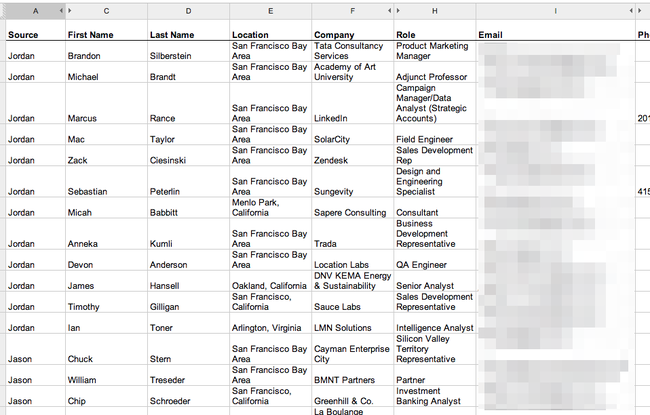
There’s gold in that list. Now let’s go get it.
Scaled Outreach: Let’s take the message to the streets #
The lead generation piece, while important, is not sufficient. Now we have to execute the outbound part of this process.
Let’s say you have 5 people on your team, including you. After this exercise is done, you should have something like 250 people in your pipeline.
Taking the message to them is going to involve scaled email outreach that leverages the social proof that their referrer works at the organization, but ultimately is about direct, templated, and repeated outreach
Templating: What are you sending?
First, you should have templated messaging that points to the job reqs that you’re hiring for, and heavily emphasizes the implicit endorsement of their referrer.
I like to have a set of outreach that follows the logic tree of typical responses. That is:
First Outreach: A “hi, howyadoin’?” that references social proof of their friend, and includes messaging (high level) on what you’re doing. Definitely needs to have hyperlinks to job postings to ensure that they can see more, and register a “click” for you to gauge interest. (People who open and click, especially multiple times, are exhibiting interested behavior, and need to be paid more attention to.)
Follow up outreach: A “Hey, in case you missed the first one” rendition of #1. Same requirements, just with a tweak to first paragraph.
A response for “Yeah, I’m interested.” In our case, this pushes the candidate to a set of fun written screening questions (more on that in another post.)
A response for “I’m good, thanks.” that includes a call to action to pass the details along to their friends and colleagues. The whole idea is to have this driven along the referral path to their, similarly good, friends.
I just took example versions of the templates I’ve used for when I was doing this for Market Development Rep and Customer Success hiring, and dropped them in this Google Doc, here: https://docs.google.com/document/d/1pQ_v68rS4gy_8LyP-t2OJe5IsEWI6EslZ36aqUEPwmY/edit
How are you going to send it?
In my case, all of these templates were housed in my TalentBin account, so I could utilize TalentBin’s integrated email and open tracking / click tracking functionality (and later, mass mailing for follow ups)
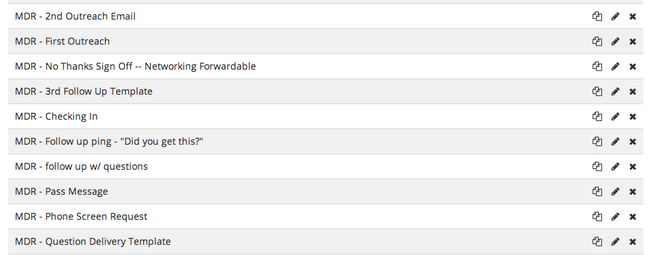
Did I mention I like to template things?
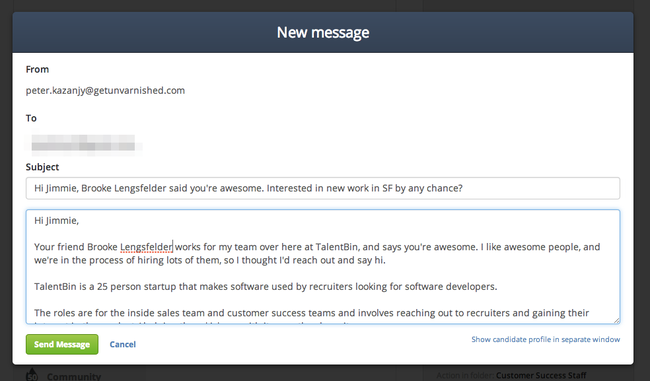
So much easier when you have mail-merge
But you can also use something like Yesware with your Gmail (I love Yesware for its open tracking and click tracking features) or even just a Google Doc with those templates, and your raw Gmail account.
All that matters is that you have a means by which to send 250 of those messages to those 250 awesome folks whom you spent all that time extracting from your staff’s network.
Also good is to notify your staff when you begin your campaign, in that a. they could also send some outreach if they like (again, it’s your job, but if they want to add, yay, bonus.), b. they may get inbound from the contact saying “Hey, your colleague Pete reached out. What’s the deal over there?” and they can help with the sales process. So give them the heads up.
So go send those 250 messages. Put on some fast music and rip through it. Flag them in your CRM as “attempting to contact”, or if you’re doing this bootstrapper style, add a column to that spreadsheet of leads, and mark them as such.
Go ahead. We’ll wait.
Response Handling and Second Pass Over the Target
Now that you’ve done that, awesome. You’re on your way to being a legit recruiter. You just did some honest to goodness headhunting.
If your messaging was solid, and the social proof was groovin’, you’re going to see a bunch of responses coming in of interest. Deal with those first, as they are, as we like to say, “closest to the money.” The positive ones, use your “positive response” template to push them into the next stage (in our case, a written screen.) The negative ones, flip them the “Thanks, can you send these to your network?” template, and you may get secondary inbound if they execute. Disposition all of that, and you’re on your way to getting some butts in seats.
But then there’s going to be the folks who didn’t respond. If you were using something like TalentBin or Yesware, you’ll actually be able to see who opened and clicked on the links, but didn’t response.
A day later, use your “Follow Up” template on them. If you have a recruiting CRM like TalentBin, you can actually just select all the folks who got the first message and didn’t respond, and hit them with a mass mail with that template.
If you don’t have a recruiting CRM, that’s fine. Just pump up the fast music again, and do a second pass across all those folks who. Use the templates and some furious copy/pasting and you’ll be done in now time.
You’d be AMAZED how much a little follow up like this helps. It gives you the chance to prove all sorts of great things like a. you’re not just a drive-by emailer, b. you have persistence and gumption, c. you really have a candidate-crush on them, as you articulated in your template (so your behavior supports your messaging!).
These things are good for recruiting (and sales), which is why we have automated follow up built into TalentBin, but they’re especially good for proactive referral recruiting, because you’re cementing the story through action that you tell in your message, and which your staff will tell when the would-be candidate invariably backchecks you with their referrer.
Again, you’ll get a certain amount of response, and you should deal with the accordingly, working “closest to the money” whenever you have a choice of what to do.
Extra credit if you want to send a “I’m breaking up with you / I guess you’re not that into me” template a few days later to all the nonrespondees. That always gets some good laughs and responses.
Can you have someone else do this for you?
Yes, you can have someone else do this for you. In fact, if you’re in the midst of scaling a sales team, or engineering team, and have a contract recruiter in house, this is the FIRST THING they should do.
Sit with each person, do the lead gen, and then bonus points if the recruiter then executes outreach as you (recruiting CRMs like TalentBin let you do delegated communication – so your tech recruiter can send email that looks like it’s coming from the VP of Engineering, or your recruiter can send sales recruiting emails that look like they’re coming from the CEO – you think those might have a higher response rate? ; )
Rinse. Repeat. #
And this isn’t a one-time thing. Think about it. For each new hire that you get out of this process, they bring ~500 new contacts to the table to mine and recruit out of. It’s the gift that keeps on giving.
Moreover, for you existing staff, this isn’t a one off thing, either. Do it on a quarterly / biannual basis. Your team is constantly meeting new and awesome people, and conveniently, connecting to them on Facebook and LinkedIn. So make sure to scoop up those deltas on an ongoing basis.
Yes, it would be great to instill a mindset of “Always Be Recruiting”, and when one of your staffers meets someone awesome they coming running with the reference. But, again, they have their own jobs to do, and this is why one very important part of this approach is making the activity someone’s job.
Go forth and mine those networks #
As with Early Stage Launch Public Relations, none of the above is really complicated.
It just requires sitting down, prioritizing, and methodically executing a less-than-pleasant task from beginning to middle to end.
I used this approach to staff seven extremely high quality Market Development Reps (and have another half dozen in the pipeline that will probably end up being hires) drawn largely from the network of our existing staff, and some new hires provided by agencies. But once we had “imported” that network from our team and any agency hires, we did our damnedest to leverage that asset, and mine the hell out of it.
You should too.

